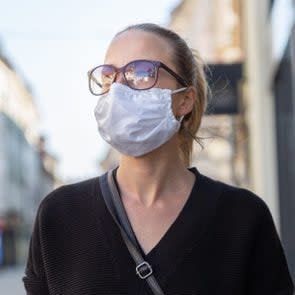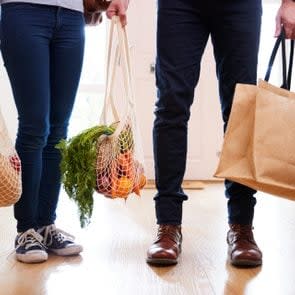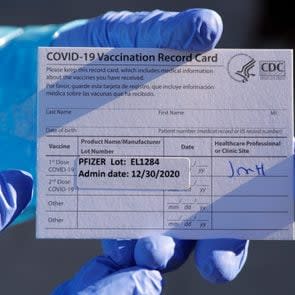6 Places You’re Most Likely to Catch Coronavirus

Just when you thought it was safe to forgo your mask and start getting back to normal, COVID-19 rates skyrocketed again, this time due to the super contagious Omicron variant and its cousin, Omicron BA.2. While infections appear to be milder—at least among the fully vaccinated and boosted—it seems that everyone has or is getting over COVID-19 these days.
What is the main way COVID-19 spreads?
COVID-19 is spread through respiratory droplets in the air when an infected person coughs, sneezes, sings, or speaks—and it doesn’t take much virus to spread Omicron, explains Len Horovitz, MD, a pulmonary specialist with Lenox Hill Hospital in New York City. This is why the CDC still recommends wearing face masks in public indoor places, even though many states are dropping mask mandates. To keep yourself safe, we recommend getting vaccinated and boosted as soon as you are able. (To that end, getting a jab is now as simple as going to Walmart, CVS, Kroger, or Costco.)
Of course, some places pose a higher risk than others. In general, infection hot spots tend to be “indoor environments with limited fresh airflow, where large numbers of people gather for longer than 10 minutes of interactions and where it is difficult to maintain physical distancing,” says Boris Lushniak, MD, dean of the University of Maryland School of Public Health in Baltimore.
In which settings does COVID-19 spread most easily?
In a study published in Environmental Science & Technology, Zhe Peng and other researchers at the University of Colorado at Boulder developed a mathematical model calculating the different factors that contribute to the level of risk for COVID-19 in different settings. These included viral factors like transmissibility and prevalence; human factors like mask use, movement, and conversation level; and air quality factors, such as room size, occupancy, and ventilation levels. Using this data, researchers are now able to attribute specific risk levels to various scenarios, and outline steps people can take to reduce their chances of catching COVID-19 in those higher risk settings.
Bars and restaurants

Regardless of the COVID-19 variant du jour, bars and restaurants are, and will always be, hot spots for virus transmission. “These places are very risky because people don’t usually wear masks, and in bars, people tend to have close face-to-face conversations at short distances in an enclosed space with poor air quality,” says Peng.
Those plastic screens between tables at restaurants aren’t really much help either, according to research from the Environmental Modelling Group. Unless the screens are specifically designed to work with airflow, they likely won’t reduce exposure to smaller aerosol particles that can easily travel around a screen.
To gauge your personal risk in this setting, Dr. Lushniak suggests taking stock of what public health recommendations are being followed. Ask yourself, “Are people wearing masks? Is the six-foot rule being applied? Is it crowded with people?” he says.
Bars and restaurants could lose their not-so-desirable top spot on this list if they check for vaccination status among patrons, says Dr. Horovitz. “Restaurants will definitely be safer if all staff and patrons are required to show proof of vaccination,” he says. “[Regardless], you still should wear a mask until you sit down at the table.” Did you know that whether you’re wearing your mask properly is one of the first things your waiter notices about you?
Gyms and fitness centers
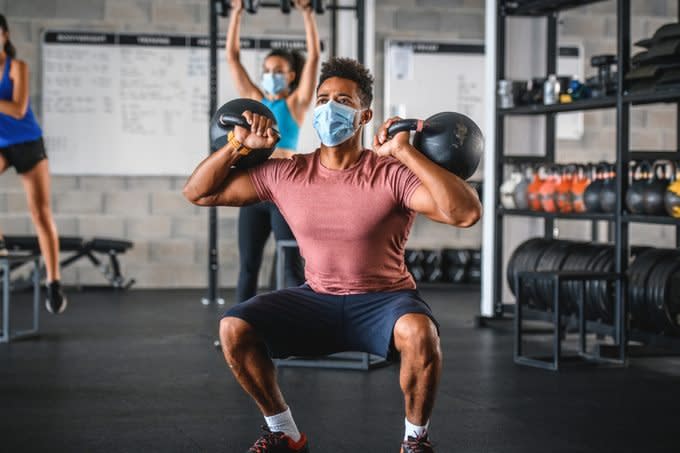
Many gyms and fitness centers are still COVID-19 hot spots, largely due to insufficient ventilation, large class sizes, and the intensity of workouts. “The most important risk factor at gyms is heavy exercise and breathing, as you can emit a lot more respiratory particles during intense exercise—even if you feel perfectly fine—which can then be inhaled by others,” Peng says.
In two reports by the CDC, scientists linked dozens of COVID-19 cases to two gyms in Chicago and Hawaii. Fifty-five gym members were infected in Chicago and 21 in Hawaii after attending fitness classes with a contagious person who did not show symptoms. While both fitness centers followed protocols such as limiting class sizes and screening for symptoms of COVID-19, neither required members to wear masks while exercising.
And if you do decide to exercise indoors, choose your gym wisely.Masks have been shown to limit the spread of COVID-19, even among those who don’t seem sick. “You can lower your risk for catching COVID-19 in the gym by wearing a mask and practicing social distance, and remaining at least 6 feet away from others,” Peng suggests.
The CDCs recommendation it that facilities open doors and windows for ventilation, installs barriers between equipment for social distancing, and requires its staff and guests to wear masks. “These practices show we care about our own health, but also the health of those around us,” Dr. Lushniak says. “This is the right thing to do and is part of the weaponry to battle the pandemic.”
Transportation
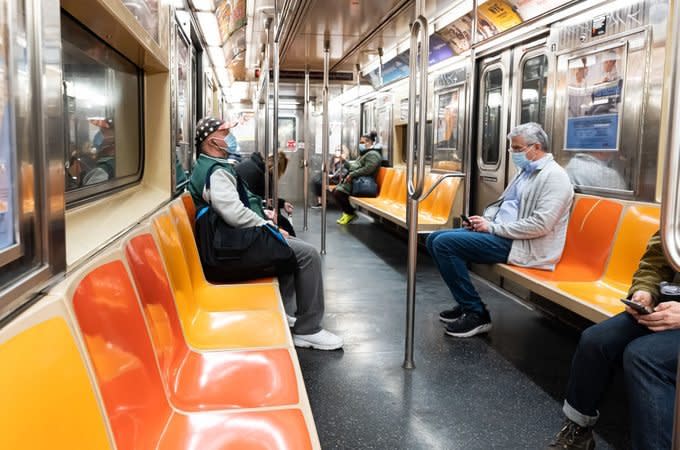
Traveling—especially on cruises and airplanes—can increase your risk of getting and spreading COVID-19, according to the CDC. The CDC recently revised its COVID-19 guidance for cruise ship travel. Now, cruise ships operating in U.S. waters can choose to participate in the CDC’s COVID-19 Program for Cruise Ships, which requires participating cruise lines to report the vaccination status classification for each cruise.
Masks are required on airplanes, trains, and buses (as well as at airports and train stations) through March 18, 2022, according to the National Transportation Authority.
In addition to mask mandates, the CDC also recommends that domestic travelers delay travel if they aren’t fully vaccinated, have had COVID-19 and haven’t ended isolation, have had close contact with a person with COVID-19, or are waiting for results of a COVID-19 test.
“I recommend wearing masks on airplanes because you are really packed in, you don’t know if the people sitting near you are infectious, and ventilation isn’t ideal,” says Peng.
School Buses prove to be safe
Closer to home, finally some good news. The risk of acquiring COVID-19 on the school bus is very low when proper precautions are taken, including open windows, mandated masking, and two kids per seat. According to a study of a Virginia-area private school published in the Journal of School Health, when these precautions were followed, there was no transmission of COVID-19 linked to busing, even during the height of the pandemic.
Crowded beaches and pools
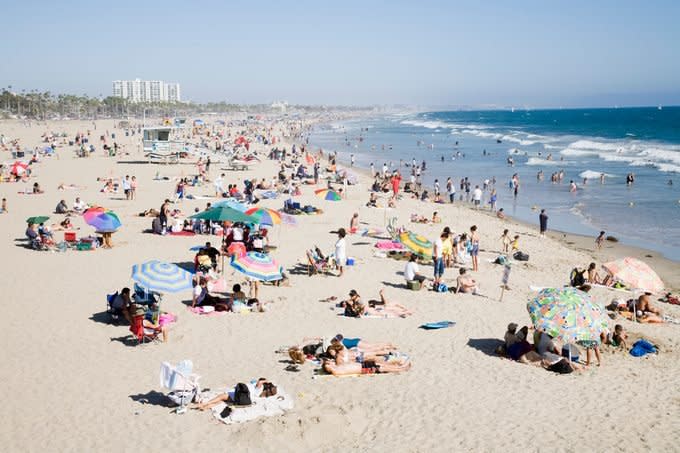
The key word is crowded. While on the one hand beaches and pools allow for more airflow than indoor environments, experts believe that viral particles can still travel from an infected person to others nearby, especially in places where people linger for hours at a time. “Risk depends on how crowded these places are,” Peng says. “When you are on the beach, you tend to stay put, and even if you are infectious, you are not exhaling vigorously,” Peng says. “Try to maintain social distance, and [if you can do that] you can remain mask-less at the beach or pool—since risk is much less than it is in any indoor place.”
Public pools may also be more problematic than people realize, says Horovitz. “When you are swimming, you are often breathing heavily, and your risk of catching COVID-19 depends on how close you are to someone who is not vaccinated,” he explains.
Sporting events, festivals, and religious services

Sorts fans might still be safer watching the big game from their couches, although a recent study found that limiting the number of people in the stands can keep the risk of COVID-19 transmission low. According to a study in JAMA Network Open, 528 NFL and NCAA football games that had limited in-person attendance during the 2020-21 season were not linked to a rise in COVID-19 cases in the community.
Similar to the situation with beaches and pools, outdoor sporting arenas are believed to be safer than indoor ones, yet the risks are evident; fans yell, chant, and sing, sit close together, travel from outside the area, and share food and personal items like noisemakers with others—all risk factors for spreading COVID-19, Peng notes. He says that the same can be said about places of religious worship where there is singing and praying.
“It all depends how big the theater or venue is,” he says. “If it is very big and people can practice social distancing and wear masks, the risk of catching COVID-19 is reduced.” Watching a movie in a theater is on the low side risk-wise, he adds. “Most people sit there quietly as opposed to a religious service where people may speak loudly or sing.”
Each place will have different rules, so don’t hesitate to ask about the property’s cleaning and disinfection protocols, says Dr. Lushniak. “All this is about your personal and your family’s health.”
Indoor social gatherings
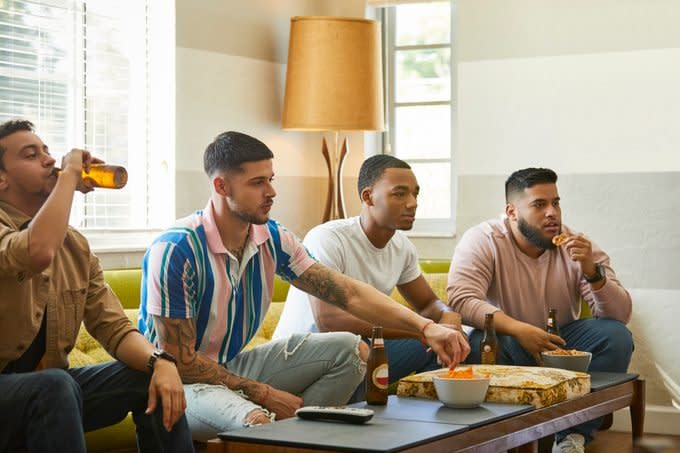
Gathering with unvaccinated friends and family who do not live with you is still discouraged by the CDC, especially if you’re indoors. Because COVID-19 is spread through tiny droplets in the air, simply being in close contact with a contagious person could increase your risk of infection, even if they don’t show symptoms. “If there is one or more infectious person at the indoor gathering, the risk of COVID-19 spreading is high,” says Peng. Testing before the event helps, he says. “If you can make sure everyone is really negative, you can gather without masks.”
Ideally, gatherings should be held outdoors or in a well-ventilated space, according to the CDC. Spacing tables and chairs six feet apart, planning social-distancing-friendly activities, wearing face masks, and washing hands frequently can further help to protect guests from infection.”If windows are open and there is a cross breeze the event is safer, but it’s not always practical to open doors and windows,” Peng adds.
Air filters can also help catch viruses circulating in the air before they reach your nose and mouth. PM2.5 particles such as pollen, dust mites, aerosols, mold, bacteria, and viruses are roughly 3 percent of the diameter of a piece of human hair and can be easily inhaled, causing or worsening existing allergies and respiratory diseases. HEPA (High-Efficiency Particulate Air) filters can remove at least 99.97% of particles that are 0.3 microns in diameter from the air. Research in Otolaryngology Head and Neck Surgery showed that portable HEPA filters can catch COVID-19 particles in your air much quicker and more effectively than non-HEPA filters.
What to do if you’ve been exposed to COVID-19
If you are feeling sick or have been exposed to COVID-19 in the past 14 days, it’s best to skip social gatherings altogether, and test yourself to confirm your COVID-19 status. That’s true regardless of your vaccination status, since breakthrough infections can occur among people who are fully vaccinated and boosted. If you test positive, isolate yourself until you test negative again to reduce your risk of spreading the virus.
The bottom line? “Any place that is crowded where people are not wearing masks is still a hot spot,” Dr. Horovitz says. And that includes your home. “Physical distancing, mask-wearing, and frequent handwashing need to become part of our culture for the near future,” Dr. Lushniak adds. Find out more about the everyday habits that could (and should) change in a post-coronavirus world.
Sources:
Len Horovitz, MD, pulmonary specialist, Lenox Hill Hospital New York City
Boris Lushniak, MD, Dean of the University of Maryland School of Public Health
Zhe Peng, research scientist, University of Colorado at Boulder
Environmental Science & Technology Letters: “Practical Indicators for Risk of Airborne Transmission in Shared Indoor Environments and Their Application to COVID-19 Outbreaks”
Environmental Modelling Group: “Role of screens and barriers in mitigating COVID-19 transmission.”
CDC: “Cruise Ship Guidance”
CDC: “Domestic Travel During COVID-19”
Federal Transit Administration: “Federal Mask Requirement for Transit”
Journal of School Health:“COVID-19 Transmission during Transportation of 1st to 12th Grade Students: Experience of an Independent School in Virginia.”
Otolaryngology-Head and Neck Surgery:” Portable HEPA Purifiers to Eliminate Airborne SARS-CoV-2: A Systematic Review”
CDC: “COVID-19 Outbreak Among Attendees of an Exercise Facility — Chicago, Illinois, August-September 2020”
CDC: “Community Transmission of SARS-CoV-2 at Three Fitness Facilities — Hawaii, June-July 2020”
Environmental Science and Pollution Research: “Infection risk in gyms during physical exercise”
Journal of School Health: “COVID-19 Transmission during Transportation of 1st to 12th Grade Students: Experience of an Independent School in Virginia”
CDC: “Outbreak of SARS-CoV-2 Infections, Including COVID-19 Vaccine Breakthrough Infections, Associated with Large Public Gatherings — Barnstable County, Massachusetts, July 2021”
JAMA Network Open: “Association of Limited In-Person Attendance in US National Football League and National Collegiate Athletic Association Games With County-Level COVID-19 Cases”
Environmental Science & Technology Letters: “Exhaled CO2 as a COVID-19 Infection Risk Proxy for Different Indoor Environments and Activities”
Signs You May Have Had COVID-19
Should You Disinfect Groceries?
Don't Share Your Vaccine Card Photos
The post 6 Places You’re Most Likely to Catch Coronavirus appeared first on Reader's Digest.
